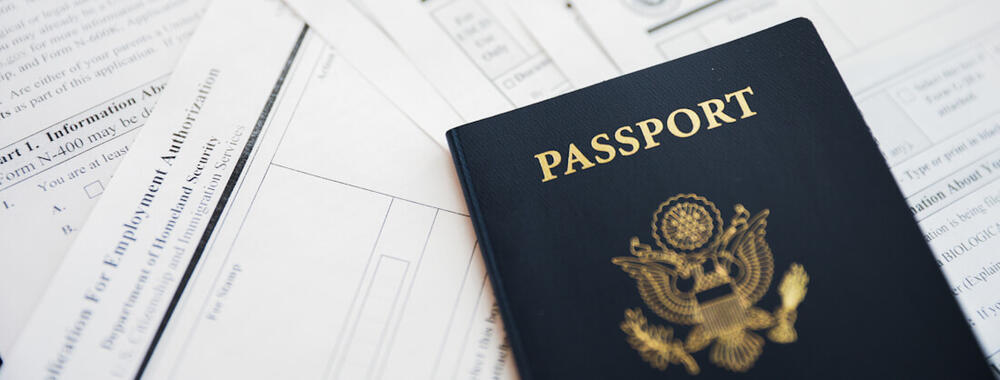- Download our Moving to the USA Guide (PDF)
Visas for the USA have become increasingly complex, with regulations that can shift significantly depending on the political climate. Whether you’re travelling to the US on holiday or making a more permanent move to take up a new job, you’ll need to understand the different types of visas for the USA and be prepared for potential policy changes.
If you’re from one of the 42 countries participating in the Visa Waiver Programme – including the UK, Ireland, Australia, New Zealand, Japan, South Korea, and most Western European countries – you may stay in the US for up to 90 days without a visa. However, you’ll need to obtain ESTA (Electronic System for Travel Authorization) approval before departure. Canadian citizens are generally visa-exempt and do not need an ESTA, though similar rules apply to their length of stay.
Here are the main visa categories you’re likely to use.
Visitor and business visas for the USA

If you’re not eligible for the Visa Waiver Programme, you’ll require a visitor visa. This visa is designed for temporary stays by international visitors and allows entry for doing short-term business (a B-1 visa), visiting as a tourist (a B-2 visa), or a combination (B-1/B-2 visa). Note that if you enter under the Visa Waiver Programme, you cannot extend your stay or change to another visa status while in the US.
You’ll need to show evidence of funds to cover your expenses and proof of strong ties to your home country, such as employment verification, property ownership, family relationships, or ongoing business interests. This will demonstrate your intention to return after your visit.
Useful links
Temporary work visas for the USA
There are several visa categories available if you want to work in the US, with each category being specific to a particular kind of work. Your prospective employer will need to sponsor your visa application in most cases. Traditionally, the H-1B and L visas were the primary routes. However, due to the prohibitive H-1B fee introduced in 2025, many professionals now look to the O-1 visa for extraordinary ability or the E-2 visa for treaty investors.
The H-1B visa applies if you’re taking up a position in a speciality occupation – in other words, workers with specific skills and knowledge who have completed higher education. From September 2025, a USD 100,000 application fee was introduced for new H-1B petitions, substantially limiting access to this visa category and making it accessible primarily to large corporations with significant resources. This shift in US immigration policy has effectively closed off this pathway for many employers and workers. Given these costs, Canadian and Mexican professionals should almost certainly explore TN status under the USMCA, which avoids both the cap and the surcharge.
The L visa (divided into L-1A or L-1B) is for employees of international companies who have been transferred to a branch in the US. L1-A is for executive and managerial employees, while L-1B is for employees with specialised knowledge.
See our comprehensive guide to Work Permits in the USA.
Useful links
- US Citizenship and Immigration Services: Temporary Workers
- US Department of State: Temporary Worker Visas
Permanent residence in the USA

The Green Card is the official document issued by the US Citizenship and Immigration Services (USCIS) to foreign nationals, granting them permanent residency in America. This allows you to live and work anywhere in the United States without restrictions.
Employment-based Green Cards
To stay permanently in the US for work purposes, you’ll need to acquire a Permanent Resident Card through one of the employment-based categories. Expats moving to the US permanently for work or investment purposes will fall into one of the following tiers:
- Employment First Preference (EB-1): Priority workers such as executives, managers and persons of exceptional ability
- Employment Second Preference (EB-2): Professionals holding advanced degrees and persons of exceptional ability
- Employment Third Preference (EB-3): Skilled workers, professionals, and other workers
- Employment Fourth Preference (EB-4): Certain special immigrants
- Employment Fifth Preference (EB-5): Foreign investors
The application process
The employment-based Green Card process generally involves three stages: obtaining PERM labour certification (typically 18 to 24 months for EB-2 and EB-3 categories), filing an I-140 immigrant petition with your employer’s sponsorship, and finally, once your priority date becomes current, submitting your I-485 permanent residence application. You’ll generally need a US employer to petition for and sponsor you throughout this process. The employer must file the relevant forms to confirm their sponsorship, and if the petition is approved, you can proceed with your permanent residence application.
You can maintain non-immigrant visa status (such as H-1B or L-1) while your Green Card application is being processed, or alternatively, wait in your home country until final approval. The entire process typically takes two to four years for most nationalities, although applicants from India and China face substantially longer waits – potentially decades for EB-2 and EB-3 categories due to per-country visa caps.
Other pathways to permanent residence
Beyond employment-based categories, Green Cards can also be obtained through immediate family members who are US citizens or legal permanent residents. This page focuses on employment and work-related pathways.
Renewing your Green Card
If you’re a lawful permanent resident with an expiring or expired Green Card, you can renew it by filing Form I-90 (Application to Replace Permanent Resident Card). As of 2024, USCIS automatically extends the validity of Green Cards to 36 months for individuals who have properly filed Form I-90, an increase from the previous 24-month extension.
Upon filing, you’ll receive an updated receipt notice. This notice, alongside your expired Green Card, serves as valid proof of your continued status and employment authorisation in the United States while you await your new card.
If you’ve lost your Green Card and require evidence of your lawful permanent resident status, you can schedule an appointment at a USCIS Field Office by contacting the USCIS Contact Center. After filing Form I-90, you can request an ADIT stamp, which provides temporary proof of your status.
Read more about Work Permits in the USA
Useful links
- US Citizenship and Immigration Services: Green Card
- US Citizenship and Immigration Services: Permanent Workers
- US Department of State: Employment-Based Immigrant Visas
Visa regulations are subject to change at short notice, and you should contact your respective embassy or consulate for the latest details.
